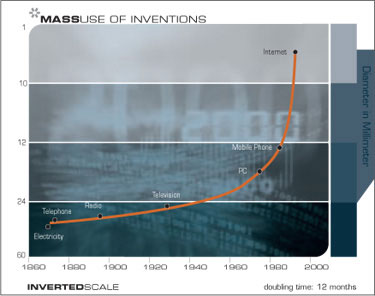| Posted: Feb 13, 2008 | |
Nanotechnology and immortality - ...really? |
|
| (Nanowerk Spotlight) How much money would you pay to live forever? $100? $1,000? $100,000,000,000? Keeping in mind that forever is a long time; you could certainly arrange some kind of longterm loan, since you’d have plenty of time to make the payments. | |
| Historically, only religions have the lock on immortality. Thus guided by divine inspiration and a codicil transcribed directly from God, most religions profess the rebirth of consciousness after the body is disposed of. Well, guess what? There are some nanotechnologists who claim that in a few decades, death will be a choice rather than a requirement. | |
| Let’s see how we can come to this rather heretical conclusion. Intel is already manufacturing devices with feature sizes about 20 nanometers across. A red blood cell is on the order of 10,000 nanometers across. In 2 dimensions we could stack about 250,000 components in the same space as a red blood cell. | |
| If the trends continue as far as 2017, which may be the end-point of Moore’s Law we could be looking at a manufactured device the size of a red blood cell with 256,000,000 components. If we add the third dimension, that could translate into 65,536,000,000,000,000 components. Somewhere along the way, we’re talking about the raw technical capability to produce a rather sophisticated robot small enough to wander around through your body doing whatever it has been programmed to do. | |
| If we make the robot 1/10,000th the volume of a red blood cell, we’re still talking about 655,360,000 components, which is arguably perhaps enough to embody this machine with the ability to think, move, and do whatever we have programmed it to do. If such a device can be built, if we have the slightest clue how to make it do things, we could, in principle, program it to go inside any cell in your body and reverse all the causes of aging simply by rebuilding the cell to a younger version of itself. | |
| If we do that to every cell in your body, and keep doing this on a regular basis, you could live forever, provided you drive safely, stay out of the sights of Al-Qaeda, and don’t live in an earthquake or flood zone. | |
| The real question is, how practical is this speculation? | |
| Well, that’s the true life or death question. Those who believe in Moore’s Law point out that it has been an accurate predictor of relevant technology for almost 40 years. It only has to hold up another decade or so before the raw technology is available. | |
| On the other hand, there are a few items missing from having raw capability and having the actual machine: | |
| 1. We don’t know how to build an autonomous robot of any real complexity. Our best technology today can create a robot that will vacuum your rug rather poorly, sometimes. | |
| 2. We don’t know how to write software that would manage an autonomous robot, even if we could build it. | |
| 3. If we had the robot, and knew how to program it, we don’t know enough about biology to tell the robot what to do once it gets there. | |
| 4. Even if we can manufacture components at the size required, we don’t know how to deliver power to the robot (although nanopiezotronics might be a solution), nor do we have any idea how to control its motion, or its actions once it gets to its place of work. | |
| The proponents of nanotechnology say, “don’t worry, technology is evolving on a logarithmic scale so these issues will be solved with unprecedented speed.” Many different technology progress curves demonstrate how things are happening at an ever-faster pace. | |
 |
|
| Source: Ray Kurzweil: The Law of Accelerating Returns | |
| One thing to keep in mind, when speculating about the future, is to keep a close eye on which trends you are using to do your forecast. I’m not suggesting that any particular trend is a good or bad forecast of things to come, but there are a few examples I like to keep in mind before preparing my investment portfolio for the really long haul. | |
| First, technology forecasts do not routinely come true. A 1965 study of the speed of human travel showed that between 1800 and 1963, humans were traveling faster and faster on a logarithmic curve, and if this trend continued, humans would be traveling just under the speed of light sometime towards the end of the 20th century. I guess we missed that curve. | |
| Second, in the 1980s, I lugged around a Kapro portable computer that used Wordstar for a word processor. I remember that it took about 1 minute to boot up this ancient application to the point where I could type my first word of wisdom. I wonder, with all the proven technology advances of the last quarter century, why does it still take about 1 minute to boot up my current laptop and word processor to the point where I can type my first word of wisdom? | |
| By Glenn Fishbine. | |
|
Become a Spotlight guest author! Join our large and growing group of guest contributors. Have you just published a scientific paper or have other exciting developments to share with the nanotechnology community? Here is how to publish on nanowerk.com. |
|
